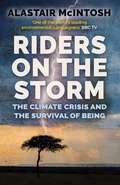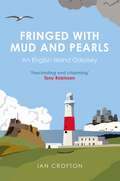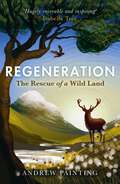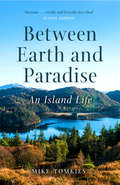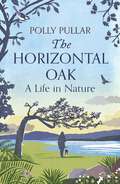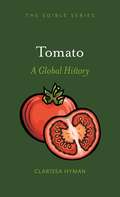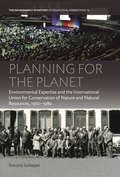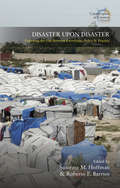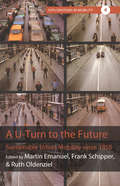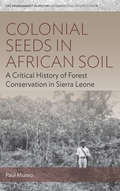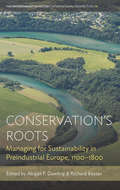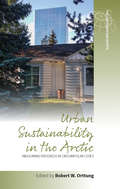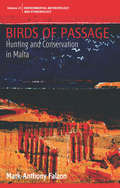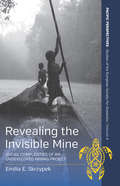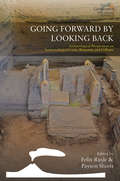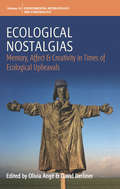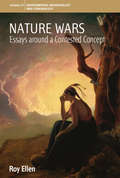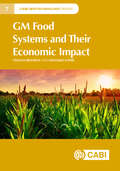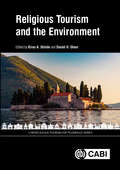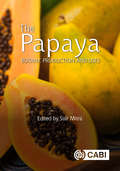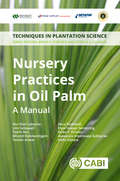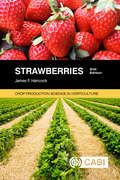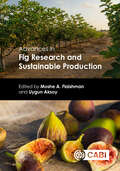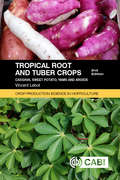- Table View
- List View
Riders on the Storm: The Climate Crisis and the Survival of Being
by Alastair McIntoshA journey into science and spirituality to help us reconnect with soil, soul, and society from “one of the world’s leading environmental campaigners” (BBC TV).Climate change is the greatest challenge to humankind today. While the coronavirus sheds a light on the vulnerability of our interconnected world, the effects of global warming will be permanent, indeed catastrophic, without a massive shift in human behavior.Writer, scholar and broadcaster Alastair McIntosh sums up the present knowledge and shows that conventional solutions are not enough. In rejecting the blind alleys of climate change denial, exaggeration and false optimism, he offers a scintillating discussion of ways forward. Weaving together science, politics, psychology and spirituality, this guide examines what it takes to make us riders on the storm.“A climate primer for our times.” —Michael E. Mann, author of The New Climate War“A profusion of ideas, insight, honesty and wit.” —The Herald“Imbued with the deepest hope for a better world.” —Sir Jonathon Porritt, author of Hope in Hell“Solid on the science yet dedicated to the human spirit.” —Professor Katharine Hayhoe, Chief Scientist, The Nature Conservancy
Fringed With Mud and Pearls: An English Island Odyssey
by Ian CroftonScotland has its rugged Hebrides; Ireland its cliff-girt Arans; Wales its Island of Twenty Thousand Saints. And what has England got? The isles of Canvey, Sheppey, Wight and Dogs, Mersea, Brownsea, Foulness and Rat. But there are also wilder, rockier places – Lundy, the Scillies, the Farnes. These islands and their inhabitants not only cast varied lights on the mainland, they also possess their own peculiar stories, from the Barbary slavers who once occupied Lundy, to the ex-major who seized a wartime fort in the North Sea and declared himself Prince of Sealand. Ian Crofton embarks on a personal odyssey to a number of the islands encircling England, exploring how some were places of refuge or holiness, while others have been turned into personal fiefdoms by their owners, or become locations for prisons, rubbish dumps and military installations. He also describes the varied ways in which England's islands have been formed, and how they are constantly changing, so making a mockery of human claims to sovereignty.
Regeneration: The Rescue of a Wild Land
by Andrew PaintingIn 1995 the National Trust for Scotland acquired Mar Lodge Estate in the heart of the Cairngorms. Home to over 5,000 species, this vast expanse of Caledonian woodlands, subarctic mountains, bogs, moors, roaring burns and frozen lochs could be a place where environmental conservation and Highland field sports would exist in harmony. The only problem was that due to centuries of abuse by human hands, the ancient Caledonian pinewoods were dying, and it would take radical measures to save them. After 25 years of extremely hard work, the pinewoods, bogs, moors and mountains are returning to their former glory. Regeneration is the story of this success, featuring not only the people who are protecting the land and quietly working to undo the wrongs of the past, but also the myriad creatures which inspire them to do so. In addition, it also tackles current controversies such as raptor persecution, deer management and rewilding and asks bigger questions about the nature of conservation itself: what do we see when we look at our wild places? What should we see?
Between Earth and Paradise: An Island Life
by Mike Tomkies&“One man&’s search for peace and beauty in an increasingly frenetic world has never read so well or so evocatively.&” —Eifion Rees, Shooting Times & Country Magazine After giving up a hectic life as a journalist in Europe and Hollywood in the late 1960s to return to his boyhood love of nature, Mike Tomkies moved to Eilean Shona, a remote island off the west coast of Scotland. There he rebuilt an abandoned croft house and began a new way of life observing nature. He tracked foxes and stags, made friends with seals, and taught an injured sparrow-hawk to hunt for itself. It was the indomitable spirit of this tiny bird that taught Tomkies what it takes for any of us to be truly free. Whether he was fishing, growing his own food, or battling through stormy seas in a tiny boat, he learned that he could survive in the harsh environment. This is the astonishing story of daring to take the first step away from urban routines and embracing a harsh yet immensely rewarding way of life which, in turn, led Tomkies to an even more remote location and inspired an acclaimed series of books on various animals and the challenges and joys of living in remote places. &“The awesome extent of his struggle to build an uncomfortable but self-supporting writer&’s life alone in an isolated crofter&’s cottage is vividly and lyrically described.&” —Sunday Express &“A treasure house of outdoor knowledge . . . It should be read slowly to fully appreciate its value.&” —Rennie McOwan, Scots Magazine
The Horizontal Oak: A Life in Nature
by Polly PullarPeppered with humour, empathy and kindness' - Sunday Post Ever since her pet sheep Lulu accompanied her to school at the age of seven, animals and nature have been at the heart of Polly Pullar’s world. Growing up in a remote corner of the Scottish West Highlands, she roamed freely through the spectacular countryside and met her first otters, seals, eagles and wildcats. But an otherwise idyllic childhood was marred by family secrets which ultimately turned to tragedy. Following the suicide of her alcoholic father and the deterioration of her relationship with her mother, as well as the break-up of her own marriage, Polly rebuilt her life, earning a reputation as a wildlife expert and rehabilitator, journalist and photographer. This is her extraordinary, inspirational story. Written with compassion, humour and optimism, Polly reflects on how her love of the natural world has helped her find the strength to forgive and understand her parents, and to find an equilibrium.
Tomato: A Global History (Edible)
by Clarissa HymanIn the history of food, the tomato is a relative newcomer outside its ancestral home in Mesoamerica. And yet, as we devour pizza by the slice, dip French fries in ketchup, delight in a beautiful Bolognese sauce, or savor tomato curries, it would now be impossible to imagine the food cultures of many nations without the tomato. The journey taken by the tomato from its ancestral home in the southern Americas to Europe and back is a riveting story full of culinary discovery, innovation, drama, and dispute. Today, the tomato is at the forefront of scientific advances in cultivation and the study of taste, as well as a popular subject of heritage conservation (heirloom tomato salad, anyone?). But the tomato has also faced challenges every step of the way into our gardens and kitchens—including that eternal question: is it a fruit or a vegetable? In this book, Clarissa Hyman charts the eventful history of this ubiquitous everyday edible that is so often taken for granted. Hyman discusses tomato soup and ketchup, heritage tomatoes, tomato varieties, breeding and genetics, nutrition, tomatoes in Italy, tomatoes in art, and tomatoes for the future. Featuring delicious modern and historical recipes, such as the infamous “man-winning tomato salad” once featured in Good Housekeeping, this is a juicy and informative history of one of our most beloved foods.
Planning for the Planet: Environmental Expertise and the International Union for Conservation of Nature and Natural Resources, 1960–1980 (Environment in History: International Perspectives #16)
by Simone SchleperIn the 1960s and 1970s, rapidly growing environmental awareness and concern not only led to widespread calls for new policies, but also created unprecedented demand for ecological expertise. This led to novel challenges for advocacy groups such as the International Union for the Conservation of Nature, which had to navigate rival scientific approaches, Cold War politics, and decolonization in their efforts to integrate the study and protection of nature into international policymaking. This book reveals how, despite their vast scientific knowledge and attempts to incorporate socially relevant themes, experts inevitably struggled to make conservation a central part of environmental politics within intergovernmental organizations like the United Nations.
Disaster Upon Disaster: Exploring the Gap Between Knowledge, Policy and Practice (Catastrophes in Context #2)
by Susanna M. Hoffman Roberto E. BarriosA consistent problem that confronts disaster reduction is the disjunction between academic and expert knowledge and policies and practices of agencies mandated to deal with the concern. Although a great deal of knowledge has been acquired regarding many aspects of the gap, such as driving factors, risk construction, complexity of resettlement, and importance of peoples’ culture, very little has gotten into protocol and procedure. Disaster Upon Disaster illuminates the numerous disjunctions between the suppositions, realities, agendas, and executions in the field, goes on to detail contingencies, predicaments, old and new plights, and finally advances solutions and the matter of outcomes.
A U-Turn to the Future: Sustainable Urban Mobility since 1850 (Explorations in Mobility #4)
by Ruth Oldenziel Martin Emanuel Frank SchipperFrom local bike-sharing initiatives to overhauls of transport infrastructure, mobility is one of the most important areas in which modern cities are trying to realize a more sustainable future. Yet even as politicians and planners look ahead, there remain critical insights to be gleaned from the history of urban mobility and the unsustainable practices that still impact our everyday lives. United by their pursuit of a “usable past,” the studies in this interdisciplinary collection consider the ecological, social, and economic aspects of urban mobility, showing how historical inquiry can make both conceptual and practical contributions to the projects of sustainability and urban renewal.
Colonial Seeds in African Soil: A Critical History of Forest Conservation in Sierra Leone (Environment in History: International Perspectives #18)
by Paul Munro“Empire forestry”—the broadly shared forest management practice that emerged in the West in the nineteenth century—may have originated in Europe, but it would eventually reshape the landscapes of colonies around the world. Melding the approaches of environmental history and political ecology, Colonial Seeds in African Soil unravels the complex ways this dynamic played out in twentieth-century colonial Sierra Leone. While giving careful attention to topics such as forest reservation and exploitation, the volume moves beyond conservation practices and discourses, attending to the overlapping social, economic, and political contexts that have shaped approaches to forest management over time.
Conservation’s Roots: Managing for Sustainability in Preindustrial Europe, 1100–1800 (Environment in History: International Perspectives #19)
by Abigail P. Dowling Richard KeyserThe ideas and practices that comprise “conservation” are often assumed to have arisen within the last two centuries. However, while conservation today has been undeniably entwined with processes of modernity, its historical roots run much deeper. Considering a variety of preindustrial European settings, this book assembles case studies from the medieval and early modern eras to demonstrate that practices like those advocated by modern conservationists were far more widespread and intentional than is widely acknowledged. As the first book-length treatment of the subject, Conservation’s Roots provides broad social, historical, and environmental context for the emergence of the nineteenth-century conservation movement.
Urban Sustainability in the Arctic: Measuring Progress in Circumpolar Cities (Studies in the Circumpolar North #3)
by Robert W. OrttungUrban Sustainability in the Arctic advances our understanding of cities in the far north by applying elements of the international standard for urban sustainability (ISO 37120) to numerous Arctic cities. In delivering rich material about northern cities in Alaska, Canada, and Russia, the book examines how well the ISO 37120 measures sustainability and how well it applies in northern conditions. In doing so, it links the Arctic cities into a broader conversation about urban sustainability more generally.
Birds of Passage: Hunting and Conservation in Malta (Environmental Anthropology and Ethnobiology #25)
by Mark-Anthony FalzonBird migration between Europe and Africa is a fraught journey, particularly in the Mediterranean, where migratory birds are shot and trapped in large numbers. In Malta, thousands of hunters share a shrinking countryside. They also rub shoulders with a strong bird-protection and conservation lobby. Drawing on years of ethnographic fieldwork, this book traces the complex interactions between hunters, birds and the landscapes they inhabit, as well as the dynamics and politics of bird conservation. Birds of Passage looks at the practice and meaning of hunting in a specific context, and raises broader questions about human-wildlife interactions and the uncertain outcomes of conservation.
Revealing the Invisible Mine: Social Complexities of an Undeveloped Mining Project (Pacific Perspectives: Studies of the European Society for Oceanists #8)
by Emilia SkrzypekExploring the social complexities of the Frieda River Project in Papua New Guinea, this book tells the story of local stakeholder strategies on the eve of industrial development, told largely from the perspective of the Paiyamo - one of the project’s so-called ‘impact communities’. Engaging ideas of knowledge, belief and personhood, it explains how fifty years of encounters with exploration companies shaped the Paiyamo’s aspirations, made them revisit and re-examine their past, and develop new strategies to move towards a better, more prosperous future.
Going Forward by Looking Back: Archaeological Perspectives on Socio-Ecological Crisis, Response, and Collapse (Catastrophes in Context #3)
by Felix Riede and Payson SheetsCatastrophes are on the rise due to climate change, as is their toll in terms of lives and livelihoods as world populations rise and people settle into hazardous places. While disaster response and management are traditionally seen as the domain of the natural and technical sciences, awareness of the importance and role of cultural adaptation is essential. This book catalogues a wide and diverse range of case studies of such disasters and human responses. This serves as inspiration for building culturally sensitive adaptations to present and future calamities, to mitigate their impact, and facilitate recoveries.
Ecological Nostalgias: Memory, Affect and Creativity in Times of Ecological Upheavals (Environmental Anthropology and Ethnobiology #26)
by David Berliner Olivia AngéIntroducing the study of econostalgias through a variety of rich ethnographic cases, this volume argues that a strictly human centered approach does not account for contemporary longings triggered by ecosystem upheavals. In this time of climate change, this book explores how nostalgia for fading ecologies unfolds into the interstitial spaces between the biological, the political and the social, regret and hope, the past, the present and the future.
Nature Wars: Essays Around a Contested Concept (Environmental Anthropology and Ethnobiology #27)
by Roy EllenOrganized around issues, debates and discussions concerning the various ways in which the concept of nature has been used, this book looks at how the term has been endlessly deconstructed and reclaimed, as reflected in anthropological, scientific, and similar writing over the last several decades. Made up of ten of Roy Ellen’s finest articles, this book looks back at his ideas about nature and includes a new introduction that contextualizes the arguments and takes them forward. Many of the chapters focus on research the author has conducted amongst the Nuaulu people of eastern Indonesia.
GM Food Systems and Their Economic Impact (CABI Biotechnology Series)
by Dr Tatjana Brankov Dr Koviljko LovreThe development of transgenic crops is revolutionary, but what does it mean for food production, prices and the environment? This is the first book to examine the economic evidence in a methodical way. It initially describes the historical evolution of biotechnology and defines key terms, before moving on to explore transgenic technology and food regime concepts. The book analyzes genetically modified organism (GMO) policy as part of overall agrarian policy, considering neoregulation in the USA, the EU, Brazil, Russia, China, India, South Africa and Serbia; as well as discussing agricultural performance, support and trade relations. The effect of transgenic food production on world food prices is also examined, along with food security at global and regional levels, and the links between GMOs and world hunger. The environmental implications of transgenic technology are considered through analysis of pesticide and fertilizer usage and efficiency, and pesticide consumption in GMO and non-GMO producing countries. Finally, the book considers the entry of transgenic ingredients into the food chain and lists the products affected. Key features: - Detailed analysis of economic data. - Comparison of international trends, including BRICS countries (Brazil, Russia, India, China and South Africa) and Serbia. - Evaluation of environmental and food security implications. - Glossary of important terms. This book will be valuable for agricultural economists, including students at Masters and PhD level. It will also be of interest to agricultural engineers, food technologists, nutritionists, industry representatives, policy makers, policy advisers and analysts and NGOs.
GM Food Systems and Their Economic Impact (CABI Biotechnology Series)
by Dr Tatjana Brankov Dr Koviljko LovreThe development of transgenic crops is revolutionary, but what does it mean for food production, prices and the environment? This is the first book to examine the economic evidence in a methodical way. It initially describes the historical evolution of biotechnology and defines key terms, before moving on to explore transgenic technology and food regime concepts. The book analyzes genetically modified organism (GMO) policy as part of overall agrarian policy, considering neoregulation in the USA, the EU, Brazil, Russia, China, India, South Africa and Serbia; as well as discussing agricultural performance, support and trade relations. The effect of transgenic food production on world food prices is also examined, along with food security at global and regional levels, and the links between GMOs and world hunger. The environmental implications of transgenic technology are considered through analysis of pesticide and fertilizer usage and efficiency, and pesticide consumption in GMO and non-GMO producing countries. Finally, the book considers the entry of transgenic ingredients into the food chain and lists the products affected. Key features: - Detailed analysis of economic data. - Comparison of international trends, including BRICS countries (Brazil, Russia, India, China and South Africa) and Serbia. - Evaluation of environmental and food security implications. - Glossary of important terms. This book will be valuable for agricultural economists, including students at Masters and PhD level. It will also be of interest to agricultural engineers, food technologists, nutritionists, industry representatives, policy makers, policy advisers and analysts and NGOs.
Religious Tourism and the Environment (CABI Religious Tourism and Pilgrimage Series)
by Kiran A. Shinde and Daniel H. OlsenThe remarkable growth in religious tourism across the world has generated considerable interest in the impacts of this type of tourism. Focusing here on environmental issues, this book moves beyond the documentation of environmental impacts to examine in greater depth the intersections between religious tourism and the environment. Beginning with an in-depth introduction that highlights the intersections between religion, tourism, and the environment, the book then focuses on the environment as a resource or generator for religious tourism and as a recipient of the impacts of religious tourism. Chapters included discuss such important areas as theological views, environmental responsibility, and host perspectives. Covering as many cultural and environmental regions as possible, this book provides: -An in-depth yet holistic view of the relationships between religious tourism and the environment; -A conceptual framework that goes beyond listing potential environment impacts; -A strong focus on explaining the universality of the deeper environmental issues surrounding sacredness and sacred places; -A discussion of the role of disease and health-related issues at mass religious gatherings. From a global writing team and featuring case studies spanning Europe and Asia, this book will be of great interest to researchers and students of tourism and religious studies, as well as those studying environmental issues.
The Papaya: Botany, Production and Uses (Botany, Production and Uses)
by Amalendu Ghosh Robert E Paull Víctor Galán Saúco Edward Evans Rebecca Ford S H Ahmad Christian Alcocer Fredy H Ballen Luis Barboza-Barquero Paul R Campbell A Chan Fure-Chyi Chen Nancy Jung Chen Ting-Chi Cheng Shih Wen Chin Rod Drew Franscisco Espadas Humberto Estrella João Paulo Fabi Gabriela Fuentes Amaranta Giron Julián Cuevas González Eric Guevara Marco V Gutiérrez-Soto Eudaldo Pérez Hernández Jian-Zhi Huang Víctor M Jiménez Chutchamas Kanchana-Udomkan Matiyar Rahaman Khan Chen-Yu Lee Wen-Li Lee Pauziah Muda M Munirah Usana Nantawan Eder Dutra Resende Jorge Manuel Santamaria-Fernandez S K Sharma N I Shukor N E Tajidin Carlos Talavera Lynton L Vawdrey Ziwei ZhouPapaya (Carica papaya) is an important and widely-cultivated tropical fruit, grown in more than 60 countries of the world. Global papaya production has grown significantly over the last few years, mainly as a result of increased production in India. Papaya has become an important agricultural export for developing countries where export revenues of the fruit provide a livelihood for thousands of people, especially in Asia and Latin America. This book includes coverage of recent research developments with the potential to improve crop yields and quality. New research has contributed to our understanding of the crop environment, plant growth and physiology of tree and fruit development with implications for both breeding and cultivation. It looks at how analysis of the papaya genome promises new, faster breeding techniques to improved cultivars and how these and other advances are helping to tackle disease like papaya ring spot viruses and major pests which cause significant losses. Key features include: updated information for sustainable papaya cultivation research developments in tackling the major production and post-harvest problems interdisciplinary and collaborative research With contributions from international experts, the book presents the current state of knowledge concerning the history, physiology, culture and marketing of papaya throughout the world. It is an essential resource for researchers, growers and all those involved in the papaya industry.
Nursery Practices in Oil Palm: A Manual (Techniques In Plantation Science Ser. #17)
by Brian Forster Umi Setiawati Fazrin Nur Miranti Rahmaningsih Yassier Anwar Nur D Laksono Heru Rusfiandi Eben Haeser Sembiring Avasarala Sreenivasa Subbarao Hafni ZaharaThis is a hands-on, practical guide to general and specific practices in oil palm nurseries to produce healthy, vigorous and uniform plants ready for field planting. There are two nursery stages, pre-nursery and main nursery. The pre-nursery receives both germinated seeds and tissue culture produced plantlets (ramets) which are planted in a relatively small area in which shade and humidity can be controlled. Once young plants are established they are transferred to the main nursery, potted-on and grown on to produce field-ready plants. Good nursery practices, using sustainable approaches where possible, aim to provide high quality planting materials for both commercial production and field trialling. The book covers: Nursery set up - pre-nursery and main nursery Fertilizer programmes Watering Culling Weeding Pests and diseases Pre-field genotypic screening and selection Quarantine nurseries This is an invaluable manual for commercial seed producers, nursery plant producers, commercial plantation companies and plant breeders, as well as researchers in oil palm. It is useful for those starting a career in oil palm production, and as a reference guide for managers and for training purposes.
Strawberries (Crop Production Science in Horticulture)
by James HancockThis new and updated edition of a popular text provides a broad, balanced review of the scientific knowledge of strawberries and their cultivation. The worldwide strawberry industry has grown substantially since the original book was published, and methods of culture have undergone extensive modifications. This volume incorporates important changes to the taxonomy of strawberries and new understanding of how its ancestors evolved. It includes coverage of new disease and pest control methods and recent developments in genomic information. These advancements have greatly improved our understanding of how flowering and fruiting is regulated, and will revolutionize the breeding of strawberries. Drawing on extensive research and practical experience, the author presents an essential text that: Includes new content on genomic data, trait genetics, and marker-assisted strategies for varietal improvement. Provides a thorough review of the evolution of the strawberry and the history of strawberry cultivation. Contains an up-to-date comparison of the cultural systems employed across the world and the physiology behind these practices. Presented in full-colour throughout, this is a core guide for academic and professional researchers, breeders and growers, advisors, extension personnel and students of horticulture.
Advances in Fig Research and Sustainable Production
by Arpan Modi Belit Balci Avital Bechar David Ben-Yakir H Zafer Can Yafit Cohen Alain Costa Dan Eisikowitch Toufic Elbeaino Mahua Ghara Ali Muhammet Gündesli Hidetoshi Ikegami Burhanettin Imrak Esref M Irget Ebru N. Kafkas Salih Kafkas Kumar Lama Simcha Lev-Yadun Margarita López Corrales Huiqin Ma Alberto Martin Kamil M. Meriç Dvora Namdar Betül K. Özer Reut Peer Antonio Piga Victor Rodov Manuel Joaquín Serradilla Sánchez Kenta Shirasawa Fatih Sen Ece Tirkaz Eleni Tsantili Ferit Turanli Christian Ponce Vera Yanlei Zhai Irit Ziffer Daniel ValeroThe common fig (Ficus carica L.) is one of the oldest fruits domesticated by humans, and is native to southwest Asia and the Mediterranean. Figs have been associated with health and prosperity since ancient times. They are rich in fibre, potassium, calcium, and iron, as well as being an important source of vitamins, amino acids, and antioxidants. In recent years, increased consumption has caused fig production to shift to new countries such as Mexico, Brazil, India, and China. However, fig is a challenging fruit crop to grow. It is susceptible to insect pests and diseases as well as injuries from abiotic stress during fruit development and ripening. As a delicate fruit it also requires complicated postharvest procedures and climate change presents additional challenges. Comprising 29 chapters written by international experts, the book includes sections on: History Biology and Orchard Management Fruit Ripening and Postharvest Management Pests and Diseases Omics Analysis Cultivars and Breeding Products and Trade. This volume serves as a comprehensive reference for current and future practices of fig production, consumption, research and innovation, and is essential for academic researchers, and those involved in research and development in the fig industry.
Tropical Root and Tuber Crops: Cassava, sweet potato, yams and aroids (Crop Production Science in Horticulture #No. 17)
by Vincent LebotRoot and tuber crops are important to agriculture, food security and income for 2.2 billion people in developing countries. These species produce large quantities of dietary energy and have stable yields under difficult environmental conditions. This second edition of Tropical Root and Tuber Crops is an authoritative treatment of four important root and tuber crops: cassava. sweet potato, yams, and aroids. The same format is followed for each crop: Origin and History, Taxonomy and Botany, Breeding and Genetics, Developmental Physiology, Agronomy, Pests and Diseases, Post-Harvest Quality and Marketing. This new edition reviews the scientific literature produced during the last decade and presents major technical advancements. Modern molecular tools have been used to clarify the phylogeny, taxonomy and origin of these species. Similar advances have been made in physiology, agronomy, pathology and product chemistry. It is essential reading for students, researchers and horticulturists.
